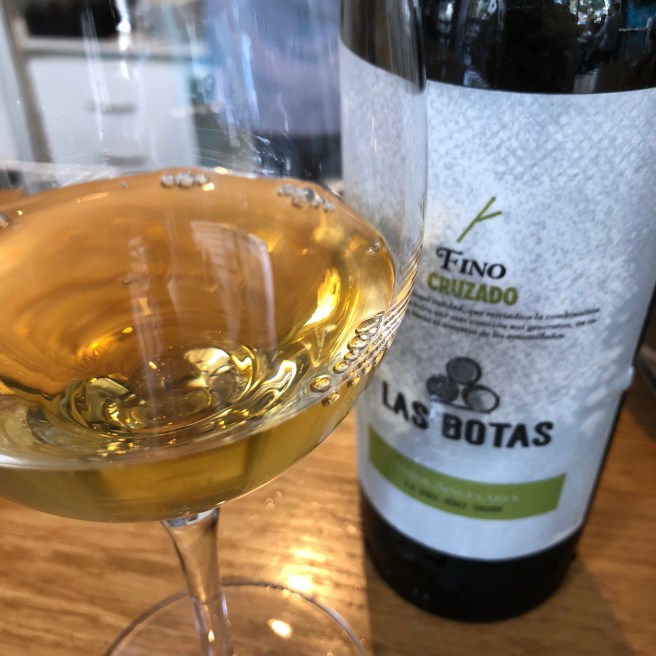
Was an honour to participate this summer in a tasting lead by Armando Guerra as part of the series of summer tastings at Taberna Der Guerrita.
A really interesting, ambitious tasting too, aiming to cover the phenomenon of the “marquistas”: the practice of selling someone else’s wine under your own brand. In fact in this case even more ambitious all the way across the spectrum from the “white label” of the supermarkets all the way up to Equipo Navazos.
Armando invited me on the strength of some musings of mine back in February on this subject and I was delighted to accept even if it is a bit of a hospital pass: for some reason people get very offended if you suggest they may be a marquista.
The scope was too ambitious for me – I am very far from an expert in white label wines and that business strikes me as absolutely distinct, in terms of the volumes, characteristics and role from the business of the “bota hunters” I am more familiar with. (In fact one interesting point to come out of the cata was the discovery of a third category in a kind of middle ground – the own-label exporters.)
That broad scope may also have prevented us from getting as in-depth into the phenomenon as we might have liked. Not that there wasn’t debate: it was a pretty lively group in the room too and there were some pretty frank exchanges of views. But for all that we didn’t really advance very far.
There really wasn’t much discussion of the supermarket level, but on the “bota hunters” and exporters there was broad speaking agreement as to their useful role: marketing and explaining the wines, providing novelty, different vision. Some in the room firmly believed that the special selections were better than the standard wines from the bodega (I tend to find the law of averages persuasive). There was also general agreement that the marquistas do most good – and least harm – when they identify the source of their wines.
But Armando made an interesting comment that rang true, which is that the “bota hunters” face an increasingly uphill task. Put simply, with the upturn in interest in these wines there are not as many special old botas lying around to be discovered, it is getting harder to find something different to say to better educated consumers and the bodegas too are getting more sophisticated in terms of their own approach, squeezing the space the marquistas used to have to themselves. Another challenge is carving out a unique message in an increasingly crowded space: new pretenders cannot simply take for their own the “magic numbers” of Equipo Navazos and you find some increasingly novel ways of describing the uniqueness of the wines.
And when you think about it it is interesting to witness the evolution of Equipo Navazos, for me the number one marquistas and one of the undisputed stars of the sherry story in recent years. You certainly can’t fault them for standing still: they may have started as bota hunters, but it is noticeable that the wines increasingly come from tried and trusted sources or from far and wide, that they increasingly make their own wines and have even diversified into rum, whisky, and even gin.
While all this was going on there was of course a lot of wine going down: or in my case, being spat out (I had to drive back). A really top lineup in fact, with everything from supermarket fino via Sacristia AB, and Equipo Navazos to the legendary “Teran Salvaje”. In fact at least one wine was wrongly included: the De la Riva oloroso in the final flight. De la Riva is a new project but certainly not a marquista. Ramiro Ibañez and Willy Perez, beloved of this parish, actually bought the solera involved (“with wood” as they say around here) and have acquired wine to refresh the solera on an on-going basis. Noone is making or bottling wine for these guys and the brand is registered in their name. (Having said all that, what an epic, flavorful oloroso – no complaints with having a glass of that.)
It was a fascinating and fun discussion albeit one that tended to confirm my beliefs rather than challenge them. I for one think that Equipo Navazos and others like them have done a fantastic service to the wines of Jerez and Sanlucar by bringing them to the attention of a wider public, and by showing how special they can be. And marquistas are always going to be around: the best marquistas have deservedly strong brands and even if they didn’t in some places it will always be easier to sell a new, exclusive label than a traditional brand.
But the marquistas are no more the future of the region than own label brands. You can see the future in fact in what Equipo Navazos (and many others) are doing – making and experimenting with new (or old) ways of making wines and focussing on vintages and terroir. In fact the real future is probably neither the marquista or the bodega, but the vineyard.


 Had to share the link to
Had to share the link to 

